Finance > QUESTIONS & ANSWERS > WGU D076 Questions and Answers Rated A (All)
WGU D076 Questions and Answers Rated A
Document Content and Description Below
WGU D076 Questions and Answers Rated A Beta A variable that describes how the price of a security varies with the market. Business Finance An area of finance that deals with sources of funding, t... he capital structure of corporations, the actions that managers take to increase the value of the firm to its owners, and the tools and analysis used to allocate financial resources. Capital Budgeting Criteria Metrics and calculations used to determine whether a project or asset will add value and be a worthwhile investment. Capital Investment The sum of money invested in a business to purchase long-term assets to further its objective of maximizing owner wealth. Capital Structure The mixture of debt and equity used to finance a firm. Cumulative A feature of preferred stock specifying that if a company skips payment of a preferred stock dividend one year, it is still required to pay that dividend sometime in the future before paying any common dividends. Defensive Assets Companies or securities with beta less than 1. Discount Rate The name for interest rate when used in time value of money calculations. Dividend Discount Model A model used to evaluate common stock that calculates the value of a share of common stock today by taking the present value of future dividend cash flows. Efficient market A market in which prices fully relect all the available information about a specific security. Holding Period Return The return over the entire period that an investor owns a financial security. Internal Rate of Return (IRR) The rate of return that a firm earns on its capital projects. Market Risk Risk that is inherent in the economy as a whole and cannot be diversified away; also called systematic risk or no diversifiable risk. Market-to-book Ratio (M/B Ratio) A market ratio found by market value of equity divided by book value of equity. Nonsystematic Risk Risk that results from factors at a particular firm and can be reduced through diversification; also called firm-specific risk or idiosyncratic risk. Perpetuity Model A formula used to value preferred stock that is based on the calculation of a perpetuity. Plowback Ratio The percent of net income retained in the firm; also called the retention ratio. Quick Ratio A liquidity ratio found by current assets less inventory, divided by current liabilities; also called the acid-test ratio. Return On Assets (ROA) A profitability ratio found by net income divided by total assets. Return The money gained or lost on an investment over a certain period of time. Risk Retention A decision to take responsibility for a particular risk. Securitization The process of combining several types of contractual debt (such as mortgages) and reselling them as a package to investors. Upside Potential The unlimited earnings potential of equity ownership. Variable Expenditures An expense that you have direct control over and that can change from period to period. Profitability Which type of ratio should be used to examine the cost efficiency of a firm's production? Current ratio Which ratio helps an analyst evaluate whether a company can cover its short-term obligations? Quick ratio Which ratio should an analyst use to consider the effect of a firm's inventory on a firm's ability to meet current obligations? Why is it important to consider the time value of money in an ideal evaluation method for capital investment? Because the value of a cash flow today is different from the value of a cash flow of the same dollar amount in 10 years Discretionary account What kind of account is Notes payable? Compound Interest equation Total Interest=Principal×(1+Interest Rate)^Number of Periods−Principal Present Value of a Perpetuity equation Present Value=PMT/i What does the DuPont Framework tell us? One is that return on all the investors (debtholders and equity holders) is measured by the firm's profitability and asset usage efficiency. The effect of debt, or in other words, the effect of the capital structure of the firm, appears only on the return on equity. How can you reduce DFN? Slow Sales Growth Examine Capacity Constraints Lower Dividend Payout Increase Net Margin What are the advantages of NPV? NPV: Considers time value of money Calculates value added to the firm Considers risk and required return What should you be aware of when calculating IRR? The solution can only be obtained through trial and error (or interpolation). What assumptions does the Gordon Growth Model make in order to make the dividend discount model usable? Dividends are paid every year. Dividends grow at a constant rate forever What should you considering in the capital budgeting process of capital investment? For the capital budgeting process of capital investment, it is essential to consider the time value of money, the risk of a project, and all the cash flows of a project to evaluate whether the project is worthwhile. What is the ideal evaluation method for capital investment? It includes all cash flows that occur during the life of the project. It considers the time value of money. It incorporates the cost of capital—or in other words, the required rate of return on the project. What do market ratios measure? Market ratios are used to evaluate the current share prices of a public firm's stock. Debt-to-Equity Ratio=Total Liabilities/Total Owners' Equity Debt-to-Equity Ratio equation What are profitability ratios used for? Profitability ratios help you understand a company's performance and cost efficiency and thereby measure a company's profitability. What are the three main comparison methods used in ratio analysis? trend analysis, cross-sectional analysis, and progress measurement Accounting The system of recording, reporting, and summarizing past financial information and transactions. Accounts Receivable Turnover (AR Turnover) An activity ratio found by credit sales divided by accounts receivable. Activity Ratios A category of ratios that measure how well a company uses its assets to generate sales or cash, showing the firm's operational efficiency and profitability. Additional Funds Needed (AFN) Another name for the discretionary financing needed or external financing needed. It represents the additional financing needed given a firm's expectations for future growth. Affirmative Covenants A bond covenant that describes things the company pledges itself to do in order to protect bondholders. Agency Costs Costs that are incurred when management does not act in the best interest of shareholders. Agency Problem When the agent (the management) does not act in the best interest of the principle (the owners). Aggressive Assets Companies or securities with beta greater than 1. Annual Percentage Rate The annual interest rate that is charged for borrowing money or that is earned through investment. Annuity Due A series of equal payments made at the beginning of consecutive periods. Annuity A stream of cash flows of an equal amount paid every consecutive period. Asset Pricing The process of valuing assets. Auction Market A secondary market with a physical location and where prices are determined by investors' willingness to pay. Average Collection Period (ACP) An activity ratio found by the number of days in a year (365) divided by AR turnover. Balance Sheet Forecasting Using sales growth and the profit forecast to construct a pro forma balance sheet to understand the future implications of the sources and uses of finances. Banks and Credit Unions Receive deposits and extend loans to individuals and businesses. Benchmarking The process of completing a financial analysis to compare a firm's financial performance to that of other similar firms. Bid-ask Spread The difference between the bid and ask prices that compensate the specialist for the risk that he or she bears for willingness to provide liquidity. Board of Directors A group of people who jointly supervise the activities of an organization. Bond Indenture A legal contract that governs the relationship between a firm and its bondholders. Bondholders A person who loans a corporation money by buying debt securities. Cannibalization The reduction in sales of a company's own products due to introduction of another similar product. Capital Asset Pricing Model (CAPM) A model used to determine the risk-return relationship for an asset. Capital Budgeting The process of evaluation and planning for purchases of long-term assets. Capital Markets A type of financial market used for long-term assets that are held for greater than one year. Capital A financial asset that can be used by a firm or individual. Examples of capital may be machinery or cash held by a firm. Capital-constrained Environment When a limited amount of funds are available. Cash Budgets A plan for controlling cash inflows and outflows business to balance income with expenditures. Cash Management Managing the day-to-day finance operations of a firm. Central Banks Ensure that a nation's economy remains healthy by controlling the amount of money circulating in the economy. Common Stock A type of stock that represents equity in a firm and confers the right to vote at shareholder meetings. Compounding Interest The interest on the principal plus the interest on earned interest. Compounding Finding a future value given a present value. Corporate Bonds A debt instrument that is issued by a corporation in order to raise capital. Corporate Governance The system of rules, practices, and processes by which a firm is directed and controlled. Correlation The measure of the relationship between two variables that move in relation to each other. Cost of Capital The cost to a firm to use an investor's capital; see interest rate. Coupon Rate The stated interest rate of a bond; also known as coupon yield. Coupon Yield The stated interest rate of a bond; also known as coupon rate. Covenants Statements in a bond indenture that outline things the company will obligate itself to do or not do in order to protect bondholders. Credit Analysts A commercial bank position with the responsibility to assess the riskiness of lending to borrowers and determining whether or not loans should be extended to potential bank clients. Cross-sectional Analysis Comparing a firm's financial ratios to other firms' ratios or industry averages. Current Market Value What someone would pay right now for an asset. Current Ratio A liquidity ratio found by current assets divided by current liabilities. Dealer Market A secondary market made up of multiple dealers that hold an inventory of securities and quote prices. Debt Ratio A financing ratio found by total liabilities divided by total assets. Debt-to-equity Ratio A financing ratios found by total liabilities divided by total equity. Default Risk The probability of a loss resulting from a borrower's failure to repay a contractual obligation; also called credit risk. Default Failure to meet a debt obligation. Discount Bond A bond whose price is below its par value. Discounting Finding a present value given a future value. Discretionary Accounts Accounts that do not vary automatically with sales but are left to the discretion of management. Discretionary Financing Needed (DFN) The additional financing needed given a firm's expectations for future growth. Diversification The process of "spreading" your money over many different assets. Dividends in Arrears A feature of preferred stock specifying that if a company ignores preferred stock dividends, it cannot pay anything to its common stockholders. DuPont Framework An expanded formula of the return of equity, net margin times total asset turnover times leverage multiplier, which represent the components of profitability, activity (efficiency), and financing. Estates Everything that a person owns or controls, especially at death. Ethical Dilemma An issue in the process of deciding between multiple options where no option is completely acceptable from an ethical standpoint. Ethics Following accepted standards of moral conduct. Expected Return A hypothesized estimate of future prices or returns under different scenarios based on expectational data. External Financing Needed (EFN) Another name for the discretionary financing needed or additional funds needed. It represents the additional financing needed given a firm's expectations for future growth. Face Value The sum of money that a corporation promises to pay at the expiration of a bond; also called par value. Finance The study of managing and allocating funds at the personal or business level. Financial Institutions An area of finance that includes firms or organizations that exist to accept a wide variety of deposits, to offer investment products to individuals and businesses, to provide loans, or to broker financial transactions. Financial Managers A person who makes strategic financial decisions in a corporation. Financial Policy Implementation Incorporating new finance ideas within a firm. Financial Risk Increased volatility in earnings as a result of using debt. Firm-specific Risk Risk that results from factors at a particular firm and can be reduced through diversification; also called nonsystematic risk or idiosyncratic risk. Fisher Effect An economic theory developed by Irving Fisher holding that the real interest rate is equivalent to the nominal interest rate minus the expected inflation rate. Fixed Asset Turnover (FAT) An activity ratio found by sales divided by fixed assets. Fixed Expenditures An expense that you do not have direct control over and that remains constant from period to period. Fixed-income Securities Another name for bonds; a financial security in which the borrower pays a fixed interest payment to investors each year. Future Value The worth of cash flows in terms of the dollar amount in the relative future. Gordon Growth Model A formula used to value common stock based on the assumptions that dividends are paid every year and grow at constant rate forever. Gross Margin A profitability ratio found by gross profit divided by sales. Harvest Generating cash or stock from the sales or IPO of companies in the portfolio of investments. Hurdle Rate The required rate of return that a company expects to earn in order to consider a project. Hybrid Security A security that has some elements that resemble equity and others that resemble debt. Idiosyncratic Risk Risk that results from factors at a particular firm and can be reduced through diversification; also called firm-specific risk or nonsystematic risk. Incremental Cash Flows Cash flows that result from accepting a project. Inflation The rate at which the average price level of a basket of chosen goods and services in an economy increases over a period of time. Initial Public Offering (IPO) When a privately held company first offers shares of stock to outside investors to raise capital, therefore becoming a publicly owned company. Insurance Companies Charge premiums to invest in bonds and stocks to pay claims. Interest Rate Risk The probability that changes in interest rates will impact the value of a bond. Interest Rate The percentage of the principal that a lender charges a borrower for the use of assets. Intrinsic Value The value of an asset as determined through fundamental analysis without referring to the asset's market value. Inventory Turnover An activity ratio found by COGS divided by inventory. Investment Bank A financial intermediary that offers complex financial transactions such as underwriting, facilitating mergers, and buying and selling financial securities on behalf of large institutions. Investments An area of finance that involves deciding which assets to invest in to create wealth in the future. Legal Following the laws and rules set by an authority. Leverage Ratios A category of ratios that consider how a firm is financed. Leverage Another name for debt or liability. Liquid Asset An asset that can be converted into cash quickly without the loss of significant value. Liquidity Ratios A category of ratios that measure a firm's ability to meet short-term obligations. Liquidity The ability to turn financial securities into cash easily without losing significant value. Market Capitalization The current market value of a publicly traded company's total outstanding shares, indicating the size of a company. Market Ratios A category of ratios that are used to evaluate the current share price of a public firm's stock. Marketing The business function responsible for generating sales. Maturity Date The date at which a bond expires. Money Market A type of financial market used for short-term assets that are held for less than one year. Morals Following one's standards of right and wrong behavior. Mutual Fund An investment company that continually offers investments and buys financial securities and instruments on behalf of investors. Mutually Exclusive When two or more events do not coincide. NASDAQ A computer network where stocks are bought and sold. It is the second-largest stock exchange in the world. Typically, technology-related companies will go public through this exchange. Negative Covenants A bond covenant that describes things the company pledges itself not to do in order to protect bondholders. Net Margin The percentage of sales remaining after all costs have been deducted from a company's total sales. Also known as net profit margin; indicates the profit earned by the firm. New York Stock Exchange (NYSE) A physical trading floor and a computer network where stocks are bought and sold. It is the largest stock exchange in the world. Nominal Rate The rate at which invested money grows for a certain period of time. [Show More]
Last updated: 1 year ago
Preview 1 out of 36 pages
.png)
Also available in bundle (1)
.png)
WGU D076 BUNDLED EXAMS QUESTIONS AND ANSWERS WITH VERIFIED SOLUTIONS
WGU D076 BUNDLED EXAMS QUESTIONS AND ANSWERS WITH VERIFIED SOLUTIONS
By Nutmegs 1 year ago
$20
17
Reviews( 0 )
Document information
Connected school, study & course
About the document
Uploaded On
Jan 13, 2023
Number of pages
36
Written in
Additional information
This document has been written for:
Uploaded
Jan 13, 2023
Downloads
0
Views
77

.png)
.png)
.png)
.png)
.png)
.png)



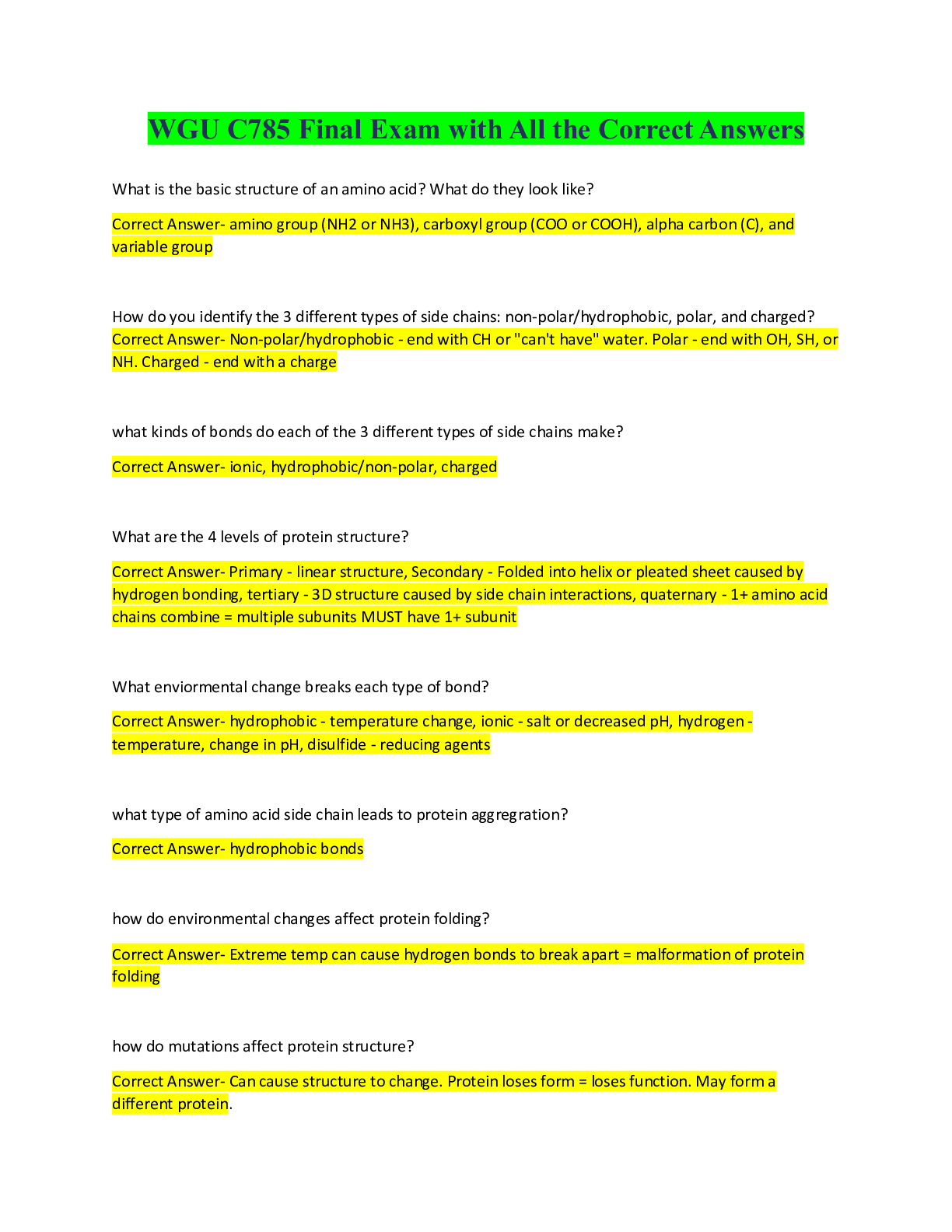
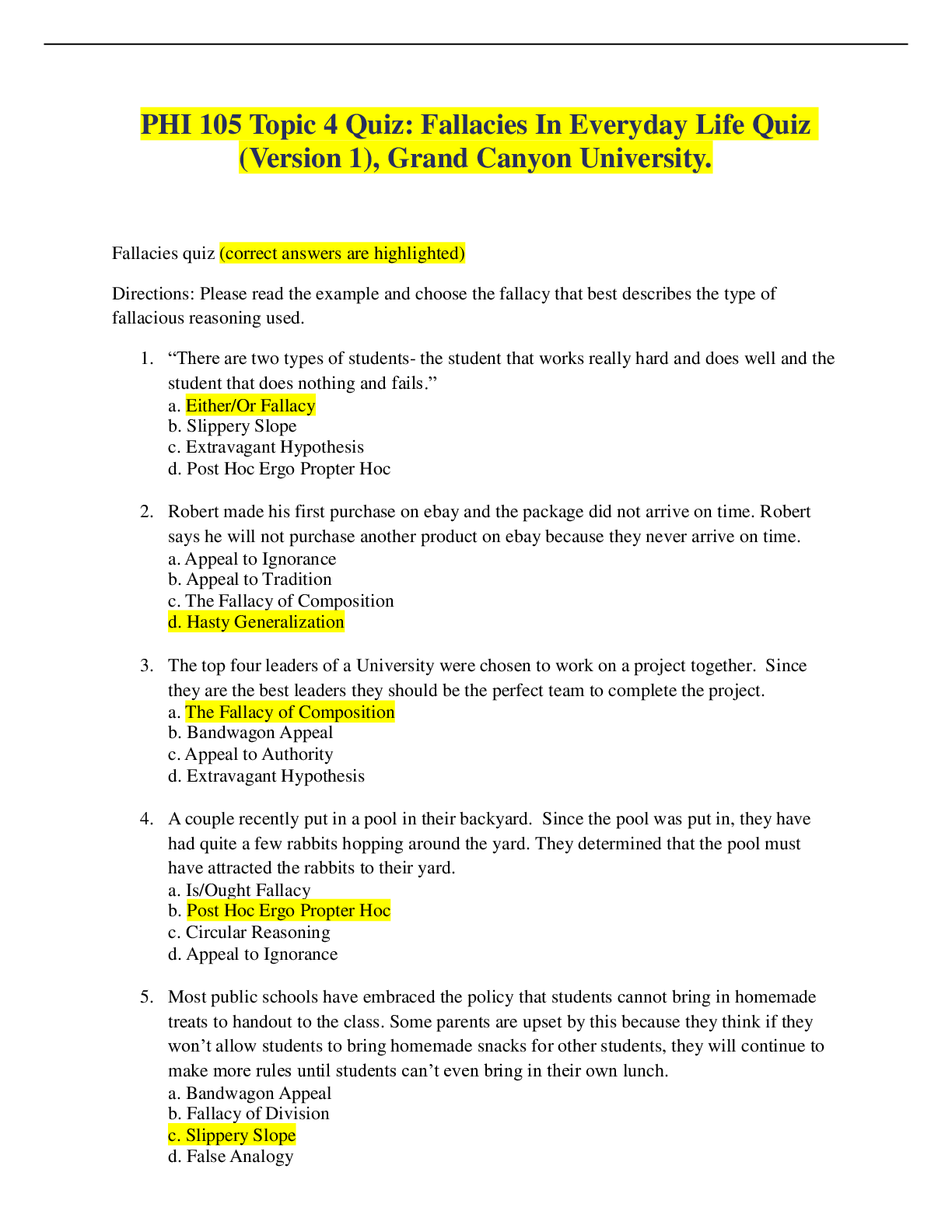
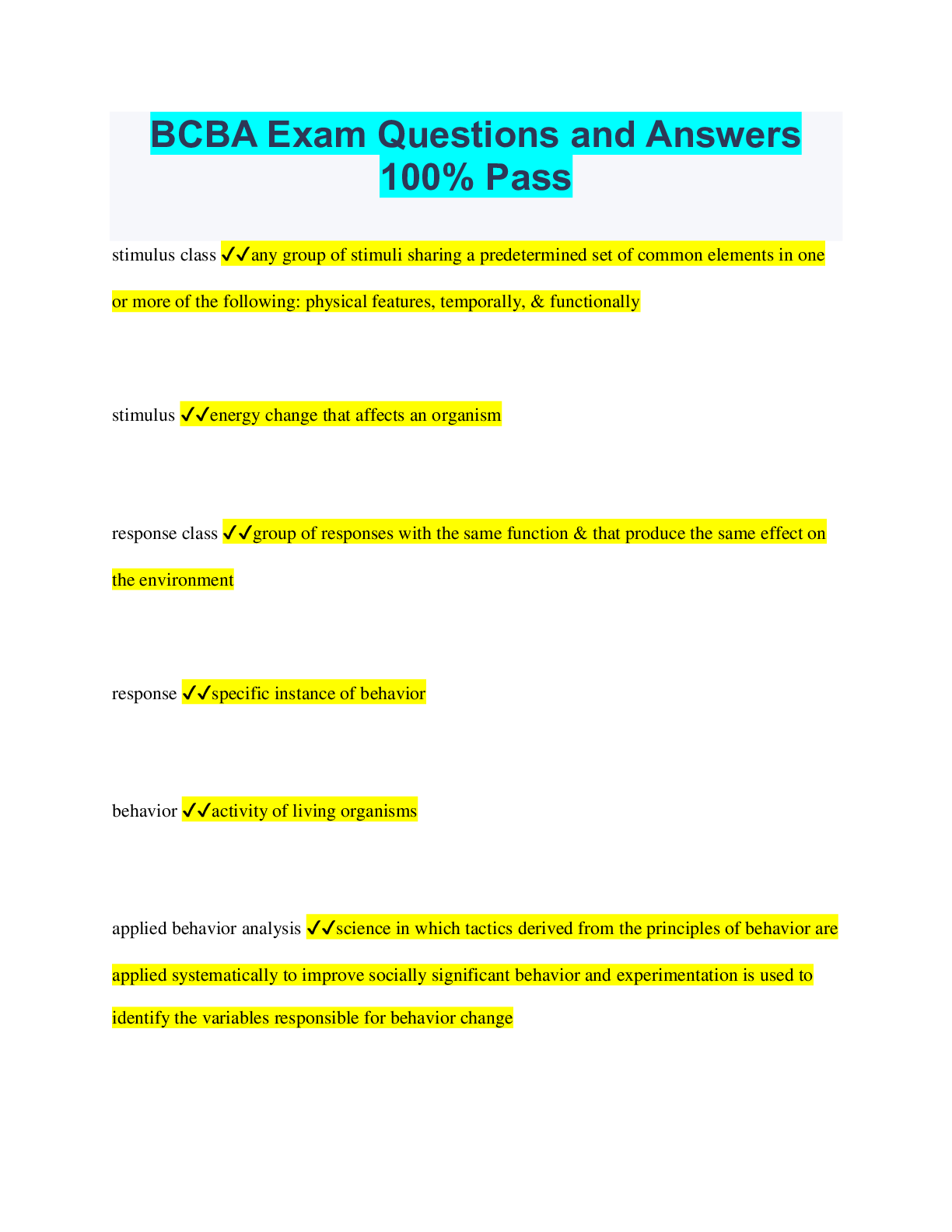
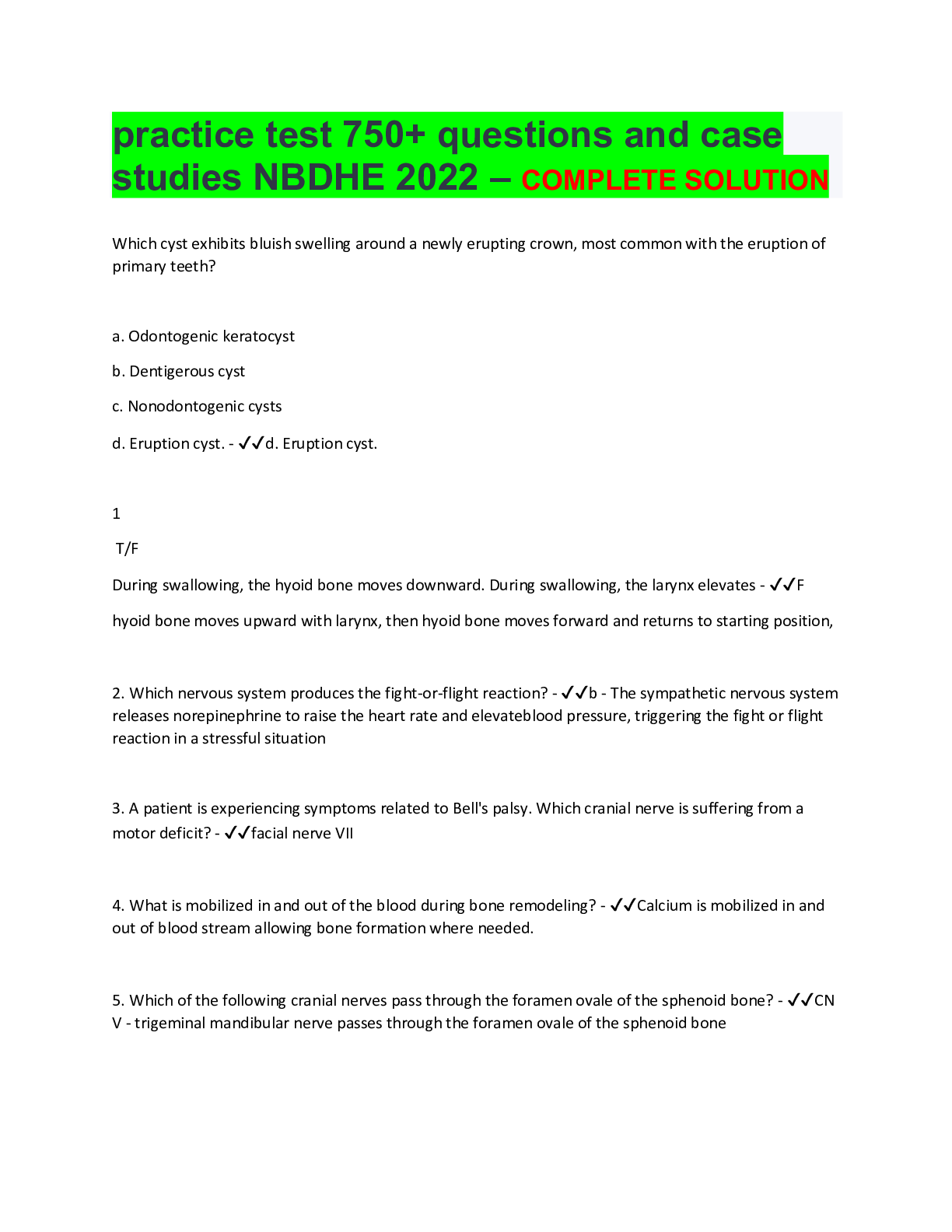
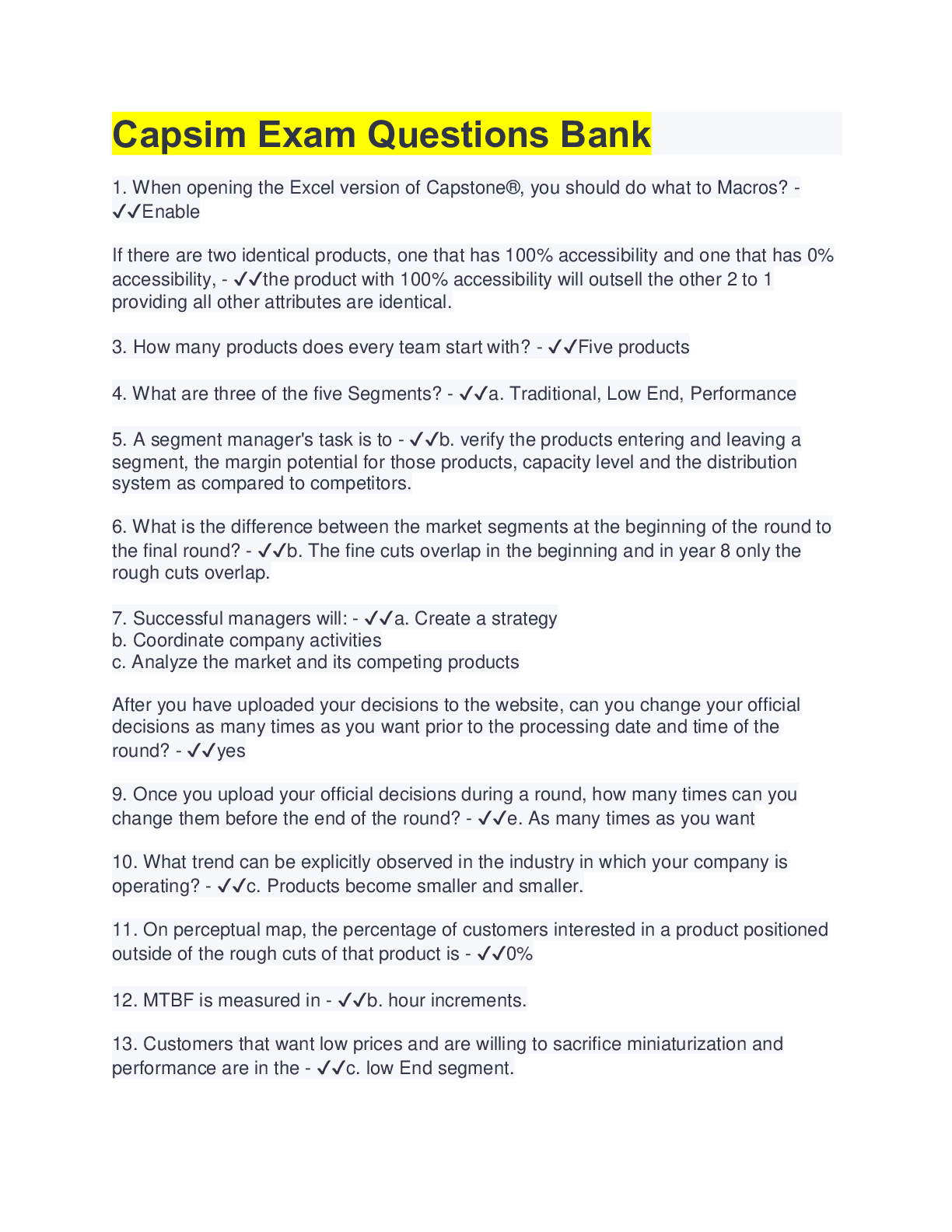







.png)





